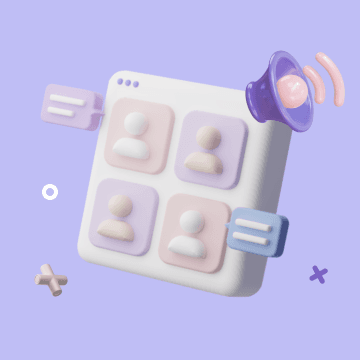
AI Agent vs Chatbot: What’s the Difference and Which One Do You Need?
1. Introduction — Why Compare AI Agents and Chatbots?
It’s not enough to say your business “uses AI.” The real question is: what kind of AI are you using?
Both chatbots and AI agents belong to the conversational AI family, yet they operate at completely different levels of intelligence and autonomy. In today’s competitive market, understanding this distinction can make or break your customer experience strategy.
According to Salesforce, 81% of customers expect faster service as technology evolves, and 73% expect better personalization. Traditional chatbots helped automate simple interactions, but the next wave of customer experience is being defined by AI agents — autonomous digital workers capable of reasoning, acting, and personalizing responses in real time.
In the short term, AI agents and traditional automation tools can work hand-in-hand — a truly ‘better together’ approach. But in the long run, AI agent platforms like Bika.ai are setting the new standard for intelligent automation, empowering users to manage AI agents, automation workflows, databases, and documents seamlessly, and transforming the way businesses operate.
2. What Is a Chatbot?
2.1 Definition
A chatbot is a rule-based conversational system that follows predefined workflows or decision trees. It relies on basic natural language processing (NLP) to recognize keywords and trigger preset responses.
In short: chatbots don’t “understand” — they match patterns.
2.2 Technical Traits
- Built manually with scripted dialogues
- Requires hundreds of training examples (“utterances”)
- No semantic reasoning or self-learning capabilities
2.3 Advantages
- Low implementation cost
- Consistent and brand-controlled responses
- Ideal for FAQs and simple, repetitive questions
Think of it like a vending machine: it offers a fixed set of snacks (responses), accepts limited inputs (keywords), and can’t make you something new.
2.4 Common Use Cases
- Customer support FAQs
- Order status queries (“Where is my order?”)
- Information collection (contact forms, feedback)
2.5 Limitations and Maintenance
While effective for standard tasks, chatbots require constant manual upkeep. Each new customer inquiry may require updating scripts, logic trees, or APIs. Even large teams managing hundreds of chatbot workflows struggle to maintain scalability — and the experience still feels robotic.
3. What Is an AI Agent?

3.1 Definition
An AI agent is an advanced AI assistant built on large language models (LLMs) like GPT or Claude. It doesn’t just follow rules — it understands context, reasons about problems, and takes action to achieve a goal.
3.2 Technical Traits
- Understands natural language and semantic meaning
- Learns from structured and unstructured business data (like help centers, CRM, or PDFs)
- Executes tasks autonomously — not just responds
3.3 Advantages
- Personalized, human-like responses
- Continuous learning and adaptation
- Can handle complex, multi-step reasoning
If a chatbot is a vending machine, an AI agent is a personal chef — it listens to your needs, combines ingredients (data), and crafts something new every time.
3.4 Real-World Use Cases
- Sales enablement: Prioritize leads or summarize CRM insights
- Customer service: Solve complex support tickets instantly
- Marketing: Generate campaign ideas and audience-specific copy
- Internal knowledge assistant: Retrieve insights from internal documents
3.5 Onboarding and Coaching
Unlike chatbots that require months of configuration, onboarding an AI agent is like hiring a new digital employee.
When I deployed my first AI agent in customer support, it connected to our knowledge base and started solving real cases within a day — no scripting required. I could “coach” it by simply saying, “Avoid negative comparisons with competitors” or “List steps one by one.”
Every update to our internal documentation automatically synced with the AI agent — no manual retraining needed.
4. Key Differences Between Chatbots and AI Agents
| Dimension | Chatbot | AI Agent |
|---|---|---|
| Core Principle | Rule-based workflows | Reasoning with LLMs |
| Language Understanding | Limited, keyword-based | Contextual and dynamic |
| Learning Ability | None | Continuous learning |
| Setup Complexity | High (manual training) | Low (auto learning) |
| Task Range | Simple, repetitive | Complex, multi-step |
| Integration | Independent chat flow | Embedded in workflows |
| Response Style | Robotic and fixed | Natural and adaptive |
4.1 Implementation Complexity
Chatbots require lengthy scripting cycles and constant maintenance.
AI agents, on the other hand, connect directly to your existing systems (like Slack, Salesforce, or HubSpot) and can be deployed in days.
4.2 Best Use Strategy
- Customer-facing: Leverage AI agents alongside chat interfaces. Use chatbots for handling routine inquiries, FAQs, appointment scheduling, and basic support, while deploying AI agents for complex requests, personalized recommendations, complaint resolution, and generating structured reports. Integrate AI agents to analyze customer feedback, track engagement trends, and provide actionable insights, ensuring a seamless and responsive customer experience.
- Employee-facing: Prioritize AI agents for workflow automation, task management, and decision support. Automate repetitive tasks such as ticket triage, email-to-task conversion, sales lead tracking, project issue summarization, and report generation. Use AI agents to monitor key metrics, analyze stock or market data, manage content pipelines, and assist in internal communications, allowing employees to focus on higher-value work.
- Expanded Scenarios:
- Marketing: Automate social media posting, campaign tracking, and content creation.
- Sales: Automatically follow up leads, update CRMs, and generate sales dashboards.
- Project Management: Track milestones, manage tasks, and summarize project updates.
- Finance & Operations: Monitor daily transactions, currency rates, and stock movements.
- Community & Engagement: Analyze forums, highlight discussions, and generate engagement reports.
- Personal Productivity: Schedule reminders, track relationships, and automate daily routines.
- This strategy ensures AI is proactive, context-aware, and embedded across all customer and employee touchpoints, turning both support and internal workflows into highly efficient, data-driven processes.
5. Example Scenario — Customer Transfers Funds Wrongly
Chatbot Experience
A chatbot provides a list of possible options or links to FAQs. It can’t reason through the problem or take corrective action.
AI Agent Experience
An AI agent identifies the urgency, accesses transaction data, and executes the required steps — such as reversing the transaction or escalating to the right department.
This personalized, reasoning-driven approach leads to higher satisfaction and faster resolution.
6. Why AI Agents Deliver Better Personalization and Speed
Customer expectations are rising fast:
- 85% of businesses think they deliver personalized experiences, but only 60% of customers agree (Twilio Segment).
- 67% of customers say speed is as important as price (Jay Baer, CX research).
AI agents deliver both. They personalize interactions on the fly, reference a customer’s full history, and act immediately — not just reply with a link.
7. Will AI Agents Replace Chatbots?
7.1 Technology Outlook
AI agents are evolving toward multi-modal capabilities — combining text, voice, and vision.
Meanwhile, chatbots will continue improving in integration and UX, serving as structured entry points.
7.2 The Future Landscape
In the short term, the hybrid model will dominate — chatbots for structured tasks, AI agents for intelligent automation.
In the long term, as generative AI matures, AI agents will lead in most complex, adaptive business scenarios.
“Agents and chatbots are better together — each serves different needs.”
8. Business ROI and Organizational Transformation
According to HubSpot, 78% of customer service professionals say AI and automation allow them to focus on the most valuable parts of their work.
AI agents transform support teams from script managers to AI strategists and coaches.
Instead of maintaining decision trees, teams now focus on analytics, optimization, and continuous improvement — maximizing ROI and customer satisfaction.
9. Conclusion — The AI-First Future
Generative AI is redefining what it means to deliver “service.”
Businesses investing in AI agents today aren’t just automating — they’re building AI-first organizations.
By onboarding an AI agent, you unlock:
✅ Faster, more human customer experiences
✅ Scalable personalization
✅ Stronger ROI with less manual upkeep
If you want to future-proof your business, partner with experts who specialize in AI agent deployment — and transform your customer experience from reactive to truly intelligent.
🧩 FAQs
Q1: What is the main difference between an AI agent and a chatbot?
→ AI agents reason and act; chatbots follow scripts.
Q2: Which should my business use?
→ For simple FAQs, use chatbots; for personalized, high-value interactions, adopt AI agents.
Q3: Will chatbots disappear?
→ Not soon — but they’ll evolve into structured front ends, while AI agents handle the real intelligence underneath.

Recommend Reading
Recommend AI Automation Templates




